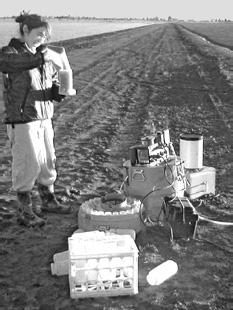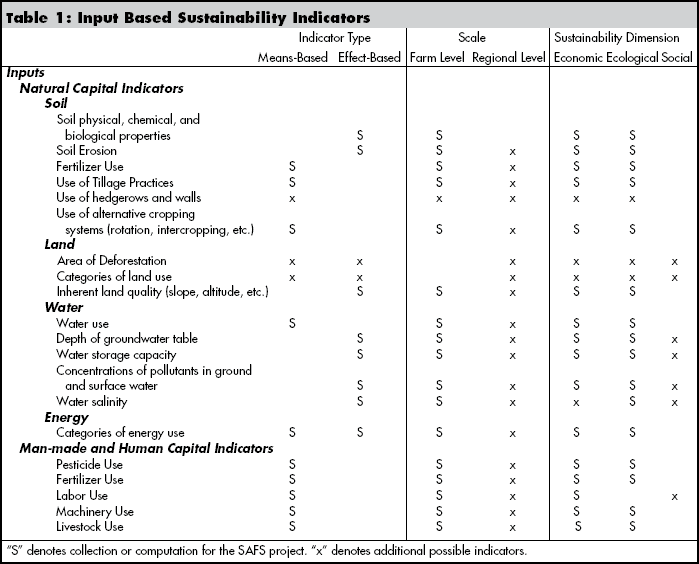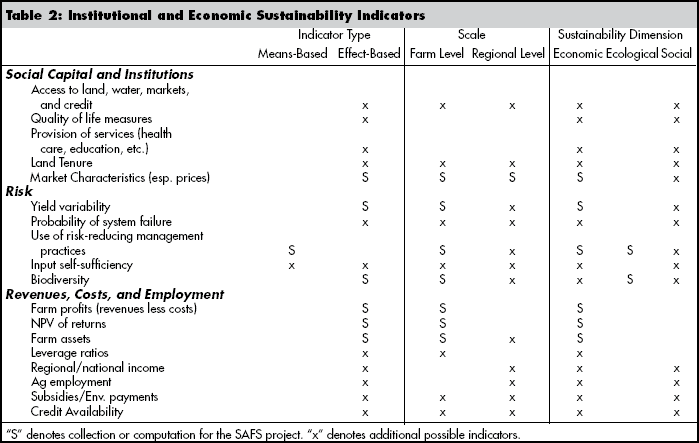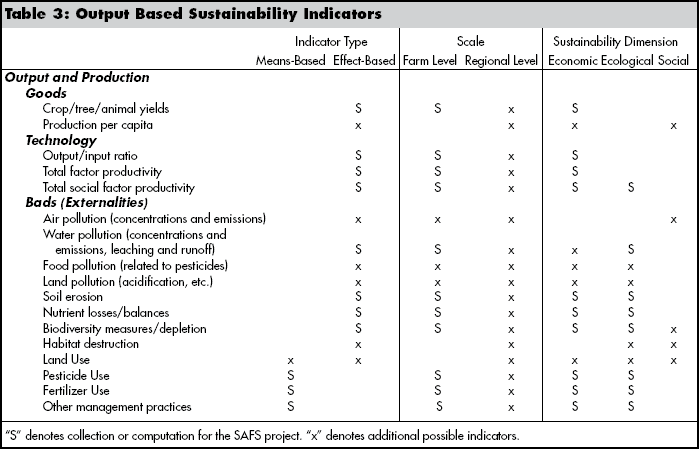|
Summer 2006 - Vol. 6/No. 3
Ecological and economic indicators for sustainability
By Craig A. Bond and Karen Klonsky
| |

Project research assistant Stephanie Ma gathers samples after a
storm at a grower’s field. (photo by Jeff Mitchell)
|
The notion of agricultural sustainability means different things to different
people, with the definition of a sustainable system dependent upon what
is to be sustained, in what form, at what scale, with what degree of certainty,
and over what time period. Broadly, however, there is some consensus
that "sustainability" encompasses
economic (financial), environmental (ecological), and social dimensions
of a system. However, unlike a typical economic problem where the goal might
be to maximize profits, or an environmental problem where the goal might be
to minimize pollution, the three dimensions of sustainability may be in competition.
For example, increasing producer profitability might involve application
of certain chemicals that have the potential to enter waterways and flow downstream,
thus causing damage to individuals not directly involved in the production
process. If decreasing this pollution resulted in increased costs (or
lower income) for the producer, then overall profits would be lowered. Economists
refer to this type of situation as a "negative externality," and it exemplifies
possible tradeoffs between dimensions of the sustainability issue.
The natural question to ask, then, is what is the optimal allocation of resources for society that balance one sustainability dimension against the other? In order to answer this question, we need information about 1) the nature of the technical relationships between elements of the agricultural and broader human and environmental systems; and 2) the valuations that individuals place on alternative attributes of those systems. Of course, this task is a monumental one for complicated agroecosystems (not to mention the varied preferences of individuals), and a complete accounting of every variable and parameter is simply impossible. The inherent uncertainty about these relationships, however, drives a demand for information about these links, with the data satisfying this demand known as indicators.
Roles of Indicators
While it may be tempting to define sustainability in broad terms, such as the oft-cited World Commission on Environment and Development’s 1987 assertion that a sustainable system "meet[s] the needs of the present without compromising the ability of future generations to meet their own needs," such definitions provide little practical guidance for system management or even information collection. As there are often competing objectives of various stakeholders, the focus of indicators should be to provide information about the tradeoffs associated with various management (or resource allocation) strategies, with a focus on adequately describing the behavior of the competing elements of a system over time and/or space.
Indicators have been classified into means-based and effects-based categories, with the former referring to measures of management practices shown or assumed to have a certain impact on the larger system, while the latter refer to measures of the system attributes directly. From a purely evaluative perspective, the "effects" indicators are usually most relevant, as it is most likely the quantity or quality changes of the characteristics themselves, rather than the means of getting there, that are valued by stakeholders. Clearly, the more direct the link between the measure of particular practice and a particular outcome, the more confidence one can have in an "effect" or "management" indicator to predict system impacts. However, in many cases, the link between the management decision and the system element might be uncertain, highly variable, or both. In fact, in agronomic field trials on experimental production systems, the goal may be to identify these links; in others, the links may be well-established by previous literature, and means-based indicators may be sufficient to indicate various trade-offs.
Types of Indicators
An economic framework provides a natural way to classify alternative stakeholder impacts and conceptually describe the interface between agriculture, the broader environment, and the social systems that comprise the rural economy. Generally speaking, the framework considers the agroecosystem from the standpoint of a social planner evaluating the relationships between inputs and outputs from the production process, and the factors that influence these relationships. More specifically, farmers convert inputs (natural, man-made, human, and social) into outputs ("goods" and "bads"), subject to technological and institutional constraints and risk preferences. Examples of sustainability indicators in each category of inputs and outputs are presented in Tables 1, 2, and 3.

Developing Sets of Sustainability Indicators
Clearly, the collection of every data
element listed in Tables 1-3 would be
prohibitively expensive and not at all optimal
once the benefits of the information gained
are taken into account. How, then, should an
indicator set be developed?

Indictors should be closely related to and
representative of the characteristics of the
agricultural system. The proper indicator set
will therefore be specific to the research project
and should be chosen to provide information
about the tradeoffs of alternative management
practices. The following guidelines should be
followed:
- Be clear about the objectives of the monitoring effort and who will use the associated information.
To provide information about links
between practices, crop performance, and
ecological impacts, care should be taken to
collect data and test hypotheses about the
effects of alternative management practices
on variables of interest. In addition, it is
critical to provide information of value
to the end-users who ultimately make or
influence management decisions, often in
the form of the tradeoffs.
- Develop a conceptual model of the system
and subsystems of interest.
There is no one “right” conceptualization,
or model, of complicated economic/
ecological systems. Developing an indicator set that represents
the key components of the conceptual model protects against
ad hoc data collection efforts, and provides the framework
for information sets of significant value. A key component
of the conceptual model is the identification of the various
stakeholders that affect and are affected by the system, and
variables that represent their (often competing) interests.
- Balance the costs and benefits of information collection.
Information gathering is costly, and there are incremental benefits
and costs to gathering each piece of data. To allow comparisons
over space and time, indicators should also be quantitative where
possible.
The agricultural sustainability indicators provided here are by
no means an exhaustive list of all possible variables, nor does the
list provide the optimal data set for any specific project. However,
it does provide an overview of possible agricultural sustainability
indicators useful in the study of tradeoffs between economic
performance and environmental quality.

Sustainable management of agroecosystems involves making
choices that affect the well-being of various stakeholders in
differential ways across both space and time. Often, changes in
technology can serve to increase the welfare of all relevant groups
(such as a production technology that keeps yields and costs
constant but decreases runoff), but some allocation decisions must adversely affect at least one stakeholder group.
The challenge is thus to collect information
that clarifies these potential tradeoffs, allowing
decision-makers to make better management
choices.
Sustainability Indicators for SAFS
The Sustainable Agriculture Farming
Systems/Center for Integrated Farming
Systems (SAFS/CIFS) project uses experiment
station resources to focus on the links
between alternative farming practices (e.g.
conservation tillage, cover crops, and manure)
and the impacts on economic and ecological
system performance at the field level. A
natural resource economics conceptualization
of the system is used to classify indicators
that are being collected, indicated by an “S” in
Tables 1, 2, and 3. The indicators will be used
to evaluate the feasibility and profitability
of alternative production systems (producer
stakeholders), as well as provide information about the potential environmental impacts of these practices (both producer and
non-producer stakeholders). Future newsletters will report these results.
• Table of Contents •
|
|